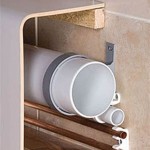How To Take the Drain Plug Out Of a Bathroom Sink
Removing the drain plug from a bathroom sink is a common task often undertaken for cleaning, retrieving lost items, or performing plumbing repairs. Although seemingly simple, the process requires understanding different drain plug mechanisms and employing appropriate techniques to avoid damage to the sink, drain, or associated plumbing. This article provides a comprehensive guide on how to safely and effectively remove various types of bathroom sink drain plugs.
Before commencing any work on the drain plug, safety precautions should be prioritized. The water supply to the sink should be shut off to prevent accidental flooding. This is typically accomplished by turning off the shut-off valves located under the sink. If shut-off valves are not present or are malfunctioning, the main water supply to the house may need to be turned off. A bucket and old towels should be readily available to catch any residual water that may be present in the drainpipe. Eye protection is also recommended to prevent splashes or debris from entering the eyes.
Identifying the Drain Plug Type
The first step in removing a drain plug is to accurately identify the type of drain plug mechanism in use. The identification of type will dictate the specific steps required for removal. There are several common types of drain plugs found in bathroom sinks, each with its own unique design and method of operation. Common types include: Pop-up drains, lift-and-turn drains, push-button drains, and stoppers.
Pop-up Drains: These drains are the most prevalent type found in modern bathrooms. They operate via a lever located behind the faucet, which connects to a linkage system that raises and lowers the drain plug. Identifying a pop-up drain is usually straightforward, as the lever behind the faucet is a clear indicator. These drains are typically removed from below the sink, which will be covered subsequently.
Lift-and-Turn Drains: These drains feature a knob on top of the drain plug. The user lifts the knob slightly and then turns it to either open or close the drain. Lift-and-turn drains are mechanically simpler than pop-up drains and are removed in a similar manner to pop-up drains, with removal often achievable from above.
Push-Button Drains: Also known as clicker drains or touch drains, these activate by pressing down on the drain plug. Pushing once seals the drain, and pushing again releases it. These drains often lack an external linkage and the entire mechanism is housed within drainpipe. They can be removed from above, which will be covered subsequently.
Stoppers: These are the simplest type, and are often simply rubber or metal plugs that are manually inserted into the drain. Some are attached to a chain, while others are removed and stored separately. Removal involves simply lifting the stopper directly out of the drain opening.
Removing The Pop-Up Drain
Once it has been verified that the drain in question is a pop-up drain, the process of removal can commence. The first stage involves locating the pivot rod underneath the sink, which is connected to the drain linkage. This rod is typically held in place by a retaining nut. The retaining nut must be loosened; this is best done with pliers or an adjustable wrench.
After loosening the retaining nut, the pivot rod can be carefully removed from the drainpipe. Be prepared for a small amount of water to spill out when the rod is removed. A bucket or towel should be positioned to catch any excess water. Once the pivot rod is removed, the pop-up drain plug itself can usually be lifted out from the top of the sink drain. If the drain is stuck, gently wiggling or rotating it may help to loosen it. A flathead screwdriver can be placed under the rim of the drain to gently lift it up.
The next step requires disconnecting the vertical rod from the horizontal pivot rod assembly. This vertical rod is typically located behind the sink faucet. To disconnect the two rods, try unfastening the screw that holds them together. If this screw is rusted or stuck, penetrating oil can aid in loosening it. The vertical rod can now be removed, and access to the drain plug is unobstructed.
At this stage, the drain plug should be free to be removed from the top of the sink. If the plug is still difficult to remove, ensure that all connections have been disconnected and that there are no obstructions preventing its removal. Lightly twisting and pulling the plug can often release it. If the drain plug body is accessible from under the sink, gently pushing upwards on the plug can aid in its extraction from the top.
Removing Lift-and-Turn and Push-Button Drains from Above
Lift-and-turn and push-button drain plugs are frequently designed for removal from the top of the sink, simplifying the process compared to pop-up drain removal. These types of drains often have a mechanism that allows them to be unscrewed or unlatched from the drainpipe.
For lift-and-turn drains, the knob on top of the drain plug is often threaded into the drain body. Holding the base of the drain plug steady, rotate the knob counterclockwise to unscrew it. Once the knob is removed, the drain plug can usually be lifted out. Some lift-and-turn drains might have a set screw that secures the knob. If present, this set screw must be loosened with a small Allen wrench before attempting to unscrew the knob.
Push-button drains often require a slightly different approach. Some push-button drains can be removed by firmly gripping the drain plug and rotating it counterclockwise. This action unscrews the entire drain plug assembly from the drainpipe. Other push-button drains may have a snap-in or latching mechanism. For these types, carefully examine the drain plug for any tabs or levers that need to be depressed or manipulated to release the plug. A small flathead screwdriver can be used to gently pry or release these latches.
It is important to apply gentle but firm pressure when attempting to remove push-button drains. Excessive force can damage the drain mechanism or the drainpipe. If the drain plug is stuck, soaking the area around the drain with warm, soapy water or a penetrating oil may help to loosen any debris or corrosion that is preventing its removal.
Upon removing any of these drain types, inspection of the drain body and drain pipe is advisable. This offers an opportunity to properly clean the drain system, removing hair, soap scum, and other debris that can cause clogs. This may involve the use of a drain snake or other plumbing tools. Proper cleaning ensures optimal drainage and prevents future problems.
During reassembly, all components should be thoroughly cleaned and inspected for damage. Any worn or damaged parts should be replaced to ensure proper function and prevent leaks. When reinstalling the drain plug, ensure that all connections are properly tightened and sealed to prevent water leakage. Teflon tape can be used on threaded connections to provide a watertight seal. If using a plumber's putty, ensure that excess putty is removed to prevent hardening and future clogs.

Need To Remove A Bathroom Sink Stopper It S So Easy

How To Release A Stuck Drain Plug In The Bathroom

How To Remove A Stopper From The Bathroom Sink Family Handyman

How To Fix A Stuck Sink Stopper Fast Easy Diy Solutions

Bathroom Sink Drain Stopper Not Working

How To Replace A Sink Stopper Quick And Simple Home Repair

How To Remove A Bathroom Sink Pop Up Stopper

Quick Tip 26 Pop Up Stopper Sticks Misterfix It Com

How To Unclog A Bathroom Sink Hana S Happy Home

Need To Remove A Bathroom Sink Stopper It S So Easy
Related Posts







